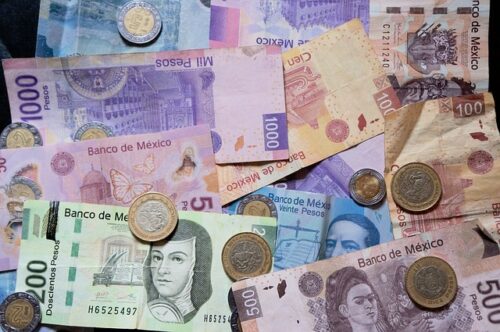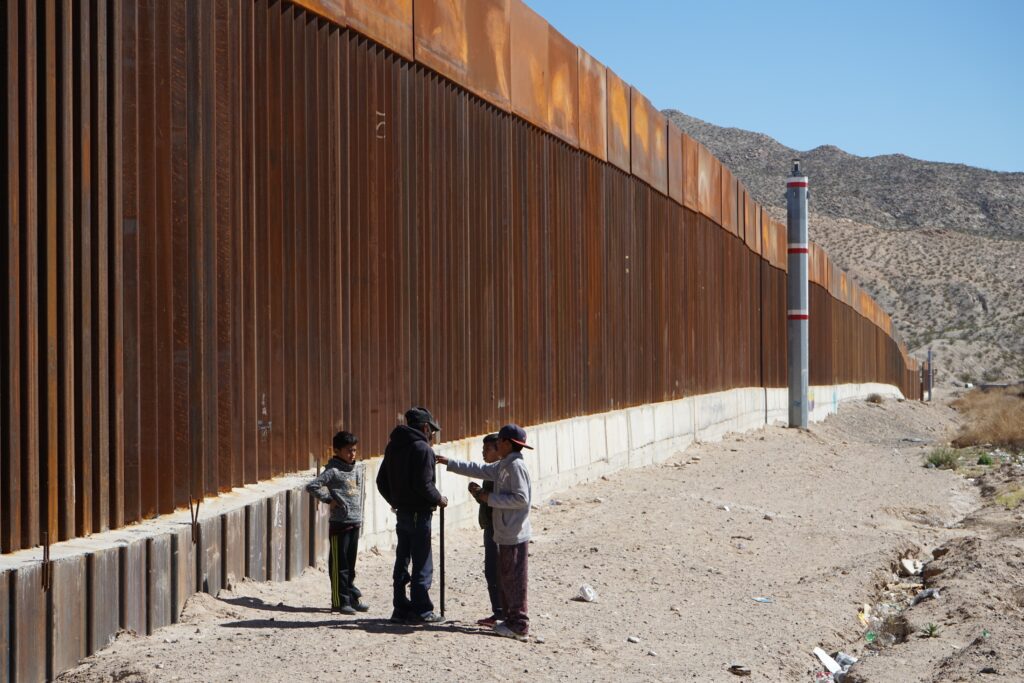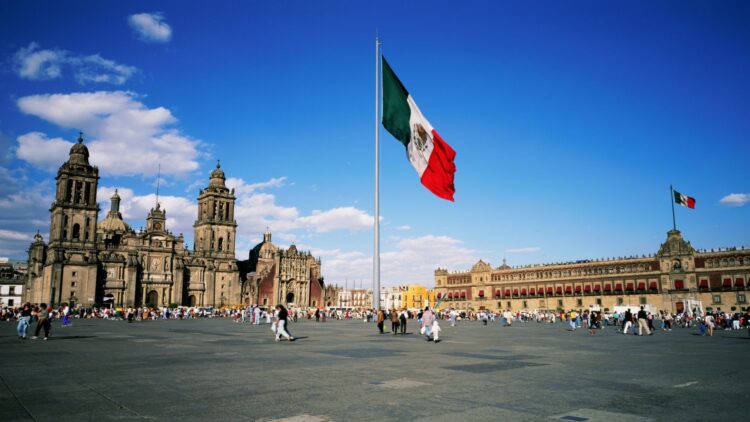The case of Mexico tells a familiar story: since the 1980s, the country has replaced the guiding hand of government intervention in the economy with the invisible hand of the market. The laissez faire principles of neoliberal economics have taken over where the state has retreated, and it has adopted these principles with uncommon enthusiasm: “Nowhere has neoliberalism been more widely implemented or its impacts have been more profound than in Mexico.”1 Economic expansion has come at the cost of a drastic increase in inequality, the disintegration of social services, the dispossession of land, and the withering away of cultural practices, all the while enriching national and transnational corporations. We’ve seen these trends throughout the world in the last three decades, but it’s in Mexico that the process has been the most stark.
…
The origins of the neoliberal project
Liberalism as an economic philosophy claimed to reflect the physical world in its mechanics, and that its application would promote positive individual and collective expression: its Enlightenment theorists argued that the “hidden hand of the market obeyed natural law and that unfettered trade would spontaneously create broad benefits.”2 In this view, the state is a disruptor of the inherent capacities of the individual, inhibiting their ability to express themselves freely and organise themselves through relationships based on unrestricted economic interaction.
The role of the state, then, was simply to facilitate economic exchange through policies of open markets and privatisation. If government was to retreat from economic decision-making, all else would self-regulate and produce sustained economic growth.
Neoliberalism was a reaction to the state-centric economics of the Cold War. The post-War boom of the 1950s and 1960s was catalysed by the Marshall Plan and similar government-led Keynesian policies of large-scale investment. State investment helped to reindustrialise war-torn countries and this, combined with a cheap labour force, caused rapid economic expansion in Western Europe and Japan.3
By the 1970s, however, these policies had been so successful that the US risked falling behind in inter-capitalist competition. The US was also losing control of the global monetary apparatus: the end of the Bretton Woods system (and thus the end of the gold standard, where the international money system currency value was pegged to physical gold reserves) resulted in the rise of speculation against the dollar, and lax monetary policies to fund the Vietnam War resulted in massive devaluation.4
In 1973, the Organization of Petroleum Exporting Countries (OPEC) quadrupled the price of crude oil to protect themselves against this depreciation,5 and the resulting ‘petrodollars’ (surplus money from increased oil revenue) were added to a large liquidity in money markets with no matching outlet in demand. This meant that there was an overabundance of dollars in the international financial system, which threatened large-scale inflation.
This, combined with the oil crises caused by the 1973 Yom Kippur War and the Iranian Revolution in 1979, caused a stagnation of the world economy coupled with inflation, which was given the imaginative term of ‘stagflation’. Something was needed to keep the engine going.
…
In 1981 Ronald Reagan was elected. Based on what his administration saw as the failures of the government-directed Keynesian project, it was buried in favour of a revival of the ‘invisible hand’ of the self-regulating free market: a new-liberalism of heavily reduced state intervention.
The Reagan administration adopted policies of monetary contraction, a rise in interest rates, the elimination of controls on capital, and decreases in corporate taxation, which initially caused a recession coupled with competition for capital internationally.6
This quake caused tidal waves around the developing world. Throughout the 1970s, given the massive availability of the dollar, and encouraged by the United States, the ‘Third World’ had been able to “borrow indefinitely from the magic liquidity machine (…) more and more debts were ‘rescheduled,’ and a number of poor countries grew flagrantly insolvent.”7 With access to funds now restricted and the demand for their natural resources falling due to recession, developing states faced large debts they could not service, and no availability of favourable credit.8
The first domino to fall was Mexico. In 1982 the country defaulted on its debt and became the testing ground for Washington Consensus institutions – the International Monetary Fund, World Bank, and the US treasury. They provided loans to service debts conditional to a restructuring of the national economy according to the tenets of neoliberalism: these were called ‘structural adjustment policies’. And just to be clear, a US institution with national duties and interests was, and still is, a director of the international financial system.
One loan document shows the methods by which the Mexican state was swayed to retreat from statist economic governance. In a 1986 World Bank report outlining a $500 million loan strategy to Mexico, import substitution – replacing imports with domestic production – and “inward development” which favoured domestic industries were seen as primary culprits of the loss of competitiveness,9 causing lack of gains in productivity,10 distorting production incentives, and driving away foreign capital.11
According to the World Bank, For Mexico to be able to balance its accounts and pay off debt, these inefficiencies needed to be resolved by “opening the Mexican economy through implementation of trade reforms, as a means of improving domestic efficiency and international competitiveness.”12
They advocated eliminating Non-Tariff Barriers (“various bureaucratic or legal issues that could involve hindrances to trade”13) and implementing import liberalisation policies which, the World Bank insisted, would result in an “improvement in the balance of payments, the gradual recovery of sustainable growth and employment based on productivity and efficiency gains, and the strengthening of external confidence and creditworthiness.”14
The Washington Consensus institutions issued three loan packages in 1982, 1986, and 1989. While this led to capital inflows, the austerity demands led to a cut in social programs and the defunding of welfare, education, and health services. Unemployment grew and the price of domestic goods increased as subsidies were abolished.15 In addition, the deregulation of exports removed “government controls that protected labor, the environment, and national resources,”16 freezing or lowering wages to make exports competitive.
The packages continued despite continued shocks and widespread protests in 1985, with the Mexican government staying the course and accepting a $10.7 billion loan in 1987 which again reduced government intervention in the economy, introduced tax reforms and privatised and de-subsidised industries, and eliminated virtually all food subsidies.17
These changes amounted to no less than a complete reorganisation of governance and society. The sudden imposition of free market principles reshuffled the economic and ownership relations among the Mexican population, and economic policy was surrendered to the market.
This held the danger of producing unequal gains as uneven development was often the result of ‘structural adjustment’: “Many developing countries suffered (…) sustained increases in prosperity, accompanied by dramatic increases in inequality and child poverty”18 under the programs.

NAFTA and uneven development: land reform and the Zapatista movement
The North American Free Trade Agreement (NAFTA) is a textbook illustration of how free market principles displaced state intervention in trade mechanics, and the resulting uneven development can be seen through the effect of agricultural reforms on the state of Chiapas.
Mexico had joined an earlier trade agreement, the General Agreement on Tariffs and Trade (GATT) in 1986, and during this era a large voting base of Mexican farmers had managed to stall extensive agricultural liberalisation.
Though farming subsidies had begun to be rolled back, GATT nevertheless “reaffirmed [Mexico’s] right to manage its agricultural policy in accordance with the ‘national interest’ and (…) afforded it continued latitude to protect its agricultural sector.”19 With the advent of near-total hands-off governance, however, during negotiations, “NAFTA’s constraints on national governments allowed TNCs [transnational corporations] active on the domestic political scene to offset the traditional influence of farmers’ lobbies.”20
This influence resulted in sweeping agrarian reforms. In 1991, three million campesinos (peasant farmers) and indigenous communities held 60% of rural land;21 however, in preparation for the implementation of NAFTA, a program of land reform was instituted in 1992 to privatise a system of communal land ownership which had existed since the Mexican revolution.
With the help of Mexican president Carlos Salinas, the World Bank targeted Mexico’s ‘ejido’ system whereby under Article 27 of the 1917 constitution, peasants had been given land and water rights as a common property which could not be bought or sold, and had to be cultivated by small producers.22 Salinas amended Article 27 to privatise these parcels and produce “efficient units,”23 going as far as creating land registries that listed them securities which could be traded on financial markets.24
These moves, combined with the abolition of subsidies and credit to small producers, “effectively undermined rural livelihoods and made it immeasurably harder for small producers to make a living in agriculture.”25 In turn, this ramped up the privatisation project as neoliberalism’s success rested “on the ability to convince peasants to relinquish their land. The only way this can be accomplished is by impoverishing the rural populace (…) Unless peasant producers sell their land, the model simply will not work.”26
The retreat of the state from providing subsidies and protecting local farmers, then, was a conscious move which facilitated this dispossession.27 The financialisaton of land illustrates the extreme lengths to which the Mexican government retreated from governance, substituting its place as a mediator and protector of communally-held property for transnational capital.
The amendment of Article 27 was more than a simple legislative change, as the law held important cultural significance. It was the brainchild of the early 20th century revolutionary Emiliano Zapata – himself a poor indigenous campesino – who mobilised the peasantry against the monopoly of agricultural land by a small cadre of families. The provision was incorporated into the 1917 revolutionary constitution, so the Salinas administration was seen to have rolled back the foundational gains of campesino and indigenous struggle.
In response, a new Zapatista movement staged a rebellion against the continuing encroachment upon farmers’ rights, which signalled “the removal of their last hope for subsistence security.”28 The Zapatista Army of National Liberation (EZLN) staged a 12-day armed uprising on the 1st of January, 1994, the day NAFTA went into effect, mobilising a large indigenous support base which had been devastated by the neoliberal pivot since the 1982 debt crisis.29 The EZLN protested the commodification of land, which saw communal subsistence and the autonomic practices of disparate ethnic groupings in the Chiapas region as inefficient.
In this, Zapatismo was an ideology antithetical to neoliberal imaginings of the relationship between people and land. In the context of a post-Article 27 Mexico where the state had retrenched and had abandoned social protections, the ELZN spokesman Subcomandante Marcos would say that at the time of the 1994 rebellion they “rose up against the Mexican government (…) only to discover that the Mexican government didn’t exist; instead, they found themselves fighting against the structure of global capital.”30
Fighting economic policy was futile, swords slashing through fog. All that was left was uneven development, with land gobbled up by the elusive ghosts of international finance.

Pictured: Subcomandante Marcos
Corn: from cultural symbol to commodity
In Mexico, corn is more than an impersonal commodity, “it is a cultural artefact that unites and crosses class, ethnicity, and race, a symbol of national identity whose transcendence approaches the domain of the sacred.”31
And this sacrality is literal: “all the Indian myths of Chiapas refer to corn as a sacred food and even the basis of physical-spiritual creation.”32 So when Article 27 was amended and the trade of corn was liberalised through NAFTA, more was at stake than tariff quotas.
In addition, corn farming had crucial physical ties to the land at the micro-level because “nearly every village [had] developed unique varieties of corn that are adapted to its particular climate, ecology, and pest profiles.”33 Liberalising agricultural trade threatened this ecosystem and placed agriculture in the hands of transnational interests.
Before NAFTA, 60% of arable land was devoted to the cultivation of maize34 and much of production occurred in ejidos, half of which were administrated by subsistence farmers.35 In exchange for access to USA’s fruit and vegetable markets, under NAFTA President Salinas opened up the corn trade to US companies who benefited from large government subsidies and a much more technically advanced farming system: they could count on 1.6 tractors per farmer, while Mexico only had one for every 50 campesino.36
This jeopardised millions of farmers’ incomes, and the transitional income support provided by the Mexican government was offset by a crash of the peso. In need of attracting foreign capital and investment to rescue the economy, and to demonstrate his commitment to free trade, Salinas forwent tariffs on over-quota corn imports and by 2009 all tariffs on the import of corn had been abolished by successive governments.37
The result is that while pre-NAFTA Mexico was self-sufficient in its corn production, the artificially low prices of subsidised US corn overwhelmed local producers so that between 1995 and 2009 not only had Mexico become a net importer of the commodity, the trade deficit for corn was larger than that of the entire agricultural sector.38 To add to the injury, genetically modified US corn contaminated local varieties, with many losing the local adaptations which had been developed over centuries.39
With this said, not all Mexican business was impacted negatively by NAFTA. Partnerships between US cornflower producers and Mexican transnational corporations like Tortimundo, the largest tortilla producer in Mexico, allowed for both industries to gain: with large producers displacing small scale farmers, they benefited from “a noncompetitive market, while the tortilla makers transfer their costs not only of flour but of other ingredients as well to the consumer.”40
In the case of one corn flower mill, Gruma, the profit margin in tortilla production increased from 2.3% in 1999 to 7.5% in 2009.41 But these profits came at a (high) price: negative consequences for food security, as price increases resulted in higher proportions of already meagre incomes spent on culturally irreplaceable food staple.
What resulted was a wealth transfer to transnational companies who were able to alter prices without concomitant falls in demand.42 In Chiapas it was observed that “the family budget was geared toward increasing consumption of the product that was culturally more accessible;”43 the poor have less disposable income and cannot supplement their diet through subsistence farming as small-scale farmers abandoned ejidos, undercut by cheap US imports.
Further cultural losses occured as migration from poor regions towards large cities and the USA, severing social ties: “it is little wonder that migration, once restricted to certain states and regions, has significantly increased everywhere among indigenous communities and ejidos.”44 Free trade and international partnerships failed to deliver on the benefits which Mexicans were promised from reduced government intervention in the market.
So not only did true development not occur in Mexico, but neoliberal policy rendered many people’s lives so precarious that formerly self-sufficient communities were forced to break apart. Many chose to head north, only to be greeted by chants of “Build the wall,” sung by people who themselves saw their dreams fade under 40 years of neoliberal policy, but who were told to look to the southern border for the culprits.

…
The retreat of the state in which began with the reforms of the 1980s has permeated through all aspects of Mexico’s economic activity in the last three decades: it has left its imprint on international trade through NAFTA, on investment partnerships between local and transnational companies which have created monopolies with minimal benefits to the consumer, and these policies have resulted in an unsettling wealth disparity between Mexicos rich and poor areas, as in Chiapas.
Neoliberal principles and the implementation of fiscal and structural reform have “destroyed the country’s industrial and agricultural productive structure as well as its public social institutions.”45 GDP has increased around the world, but we all have to look back at our personal histories and think, was it really worth it? Forty years on, can we collectively say that financial access to housing, education, land, and food have improved? If not, where has that money gone?
1 Thomas Weaver et al., eds., Neoliberalism and Commodity Production in Mexico (Boulder, CO: University Press of Colorado, 2012), 2.
2 Ibid., 34.
3Giovanni Arrighi, “The World Economy and the Cold War, 1970-1990,” in The Cambridge History of the Cold War, ed. Melvyn P. Leffler and Odd Arne Westad (Cambridge: Cambridge University Press, 2011), 25.
4 Ibid., 29.
5 Ibid.
6 Ibid., 32.
7 David P. Calleo, The Imperious Economy (Cambridge, MA: Harvard University Press, 1982), 138.
8 Arrighi, “The world economy and the Cold War,” 32.
9 Ibid., 2.
10 Ibid., 3.
11 Ibid., 5-6.
12 Ibid., v.
13 “Non-Tariff Barriers: Red Tape, Etc,” The World Trade Organisation, accessed June 19, 2021, https://www.wto.org/english/thewto_e/whatis_e/tif_e/agrm9_e.htm.
14 World Bank, Report no. P-4366-ME (July 4th, 1986), v.
15 Thomas Weaver et al., eds., Neoliberalism and Commodity Production in Mexico, 4.
16 Ibid.
17 World Bank, Report no. P-4664-ME (October 21, 1987), The World Bank Group, available at: https://documents1.worldbank.org/curated/en/160371468282298653/pdf/multi0page.pdf.
18 Michael P. Dooley and Jeffrey A. Frankel, Managing Currency Crises in Emerging Markets (Chicago, Illinois: University of Chicago Press, 2003), 363.
19 Ibid., 220.
20 Stephen Clarkson, Does North America Exist? Governing the Continent after NAFTA and 9/11 (Toronto, Ontario: University of Toronto Press and Woodrow Wilson Center Press, 2008), 207.
21 Ibid.
22 World Bank, “Mexico Ejido Reform Avenues of Adjustment: Five Years Later,” Report no. 18897 (July 1, 1999), the World Bank Group, available at: https://documents1.worldbank.org/curated/pt/252121468774688014/pdf/multi0page.pdf, vii.
23 Ibid.
24 Thomas Weaver et al., eds., Neoliberalism and Commodity Production in Mexico, 8.
25 Ibid.
26 Enrique Astorga, “Frustrations and Hopes of the Agricultural Economy,” Rural Journal, Supplement, quoted in A. Ríos, “Maize and Indigenous Communities of Oaxaca,” 101.
27 Alvaro González Ríos, “Maize and Indigenous Communities of Oaxaca, 101.
28 Richard Stahler-Sholk, “Resisting Neoliberal Homogenization: the Zapatista Autonomy Movement,” Latin American Perspectives 34, no. 2 (2007): pp. 48-63, 52.
29 Richard Stahler-Sholk, “The Zapatista Social Movement: Innovation and Sustainability,” Alternatives: Global, Local, Political 35, no. 3 (2010): pp. 269-290, 270.
30 Ibid., 48.
31 Jorge López Arévalo, Bruno Sovilla, and Germán Martínez Velasco, “National Symbolism and Tortilla Price Increases in Urban San Cristóbal De Las Casas, Chiapas,” Latin American Perspectives 39, no. 6 (2012): pp. 212-225, 213.
32 Ibid.
33 Thomas Weaver et al., Neoliberalism and Commodity Production in Mexico, 325.
34 Stephen Clarkson, Does North America Exist?, 223.
35 Ibid.
36 Ibid., 206.
37 Ibid., 224.
38 Jorge López Arévalo et al., “National Symbolism and Tortilla Price Increases,” 215.
39 Alvaro González Ríos, “Maize and Indigenous Communities of Oaxaca: Two Victims of Neoliberalism,” in Neoliberalism and Commodity Production in Mexico, ed. Thomas Weaver et al. (Boulder, CO: University Press of Colorado, 2012), pp. 100-112, 109.
40 Ibid., 217.
42 Jorge López Arévalo et al., “National Symbolism and Tortilla Price Increases,” 222.
43 Ibid., 221.
44 Alvaro González Ríos, “Maize and Indigenous Communities of Oaxaca,” 105.
45 Asa Cristina Laurell, “Three Decades of Neoliberalism in Mexico,” International Journal of Health Services 45, no. 2 (2015), 247.

